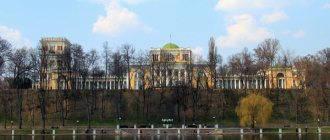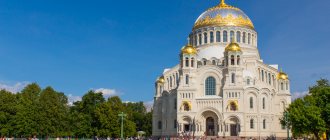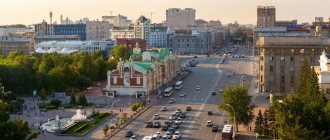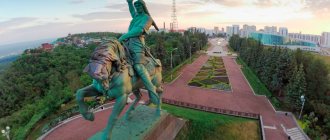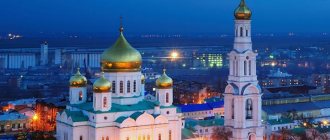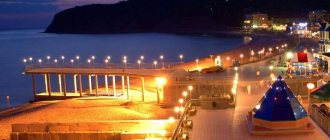- August 26, 2018
- Directions
- Liliya Shevchuk
Stary Oskol is a city located on the banks of the river of the same name in the Belgorod region of Russia. Coming here, every tourist asks the question: where to go for fun in Stary Oskol, what attractions are there, what can you see? But this city is interesting not only for its history and military glory - there are many historical, cultural and natural monuments here.
Brief information about the city
Before recommending where to go in Stary Oskol, you should tell us a little about the city itself. Its history began in the 14th century from a small village called Ugly. In 1571, by decree of Ivan the Terrible, Angly was transformed into the Oskol fortress, which served to protect the southern borders of the state and strengthen them. In 1596, Oskol acquired the status of a city, and in 1655 it received the prefix “Old” to its name, since one of the neighboring cities began to be called Novy Oskol.
The city may be of interest to a huge number of tourists: some will be interested in ancient buildings, others - the military glory of the Great Patriotic War, captured in sculptures and memorials, and others will be most interested in natural monuments of federal significance. Let's take a closer look at the most interesting places in Stary Oskol, where every tourist should go.
Temples and churches
Temple of St. Sergei of Radonezh
Address: Mr. Dubrava, 32A Telephone: Website: https://hram-oskol.ru Opening hours: 07:00 – 19:00, daily Cost: free
The Temple of Sergei of Radonezh was built quite recently. The foundation stone was consecrated in 2007, and the completed shrine began to fully function in 2021. At each stage, more and more new parts of the temple were consecrated. On July 21, 2010, bells cast specifically for this shrine were installed.
Inside the temple is decorated with paintings, mosaics and icons, which seemed to come to life after the consecration. The lower church was consecrated in honor of the Feodorovskaya Icon of the Mother of God, which was especially revered in the family of Alexander Nevsky, the heavenly patron of Stary Oskol.
Church of the Ascension of the Lord
Address: st. Mira, 24 Telephone: Opening hours: 08:00 – 14:00, daily Cost: free
The oldest temple was founded in 1870, and it was consecrated twelve years later in honor of the Archangel Michael and the healer Panteleimon. In the first half of the twentieth century, when the authorities fought against the Orthodox Church, Father Andrei, who served in the church, was arrested. Because of this, the temple suspended its activities; in those days, the church premises were used for storing grain.
In the 1980s, restoration of the temple began, and in 2011 the church was crowned with new bells, purchased with funds from an unknown donor. Currently, the architectural monument has been completely restored and is functioning.
Temple of Princess Olga and Anastasia
Address: st. Tokareva, 4/1
Construction of the small church began in 2007 and ended in August 2008, when it was fully consecrated by Archbishop John of Belgorod and Stary Oskol.
When creating the temple, only wood was used: the building itself was built from larch, and the domes with crosses were made from aspen. Oak was used to make the altar and iconostasis. All trees were brought from Arkhangelsk forests.
The building has a small refectory and a tented bell tower. The church often hosts services, which are attended by students from Orthodox gymnasiums.
If you have not yet chosen where you will live and want to save money when booking, we recommend using the RoomGuru service. Firstly, it contains hotels, apartments and guest houses from many different booking systems, so you won’t miss out on a worthwhile option. Secondly, you can immediately compare prices for one place in different services and book where it is cheaper (this is not always Booking!).
"Ataman Forest"
First of all, among the attractions of Stary Oskol, we should mention the memorial complex dedicated to the soldiers of the Great Patriotic War, which was created in 1968 on the territory of the Ataman Forest. The name of the memorial is due to the fact that since 1943 there have been a large number of unmarked burials and mass graves in this forest.
The memorial acquired its modern appearance in 1980. This event was timed to coincide with the 35th anniversary of the Victory. The memorial stele is surrounded by greenery, surrounded by small areas that serve as a reminder of the ancient forest. In addition to the monument to military glory built here, the Ataman Forest is also distinguished by the fact that it is a natural monument of the city.
Parks and streets
Lenin Street
The main street of the historical district of Stary Oskol is Lenin Street. It divides the entire city into almost two identical parts. On one side are the southwestern residential neighborhoods, and on the other are the northwestern ones, united under the name “New City.”
During the development of the city plan at the end of the 18th century, the street was named Kurskaya in honor of the Kursk province. It received its modern name in the year of Lenin’s ninetieth birthday.
Before the revolution, on the main street there were six churches, numerous beer establishments, houses and shops that belonged to merchants. Now there are shops, catering establishments, various private offices and reception rooms of government officials. There are also two city museums - local history and art.
Stary Oskol Zoo
Address: Belgorod region, Starooskolsky district, Chumaki village Telephone: , Website: https://oskol-zoo.ru Opening hours: summer (from April 1) 10:00 – 19:00, winter (from November 1) 10 :00 – 17:00, seven days a week Cost: adult ticket – 150 rubles, children’s ticket – 50 rubles. How to get there: bus routes 333 and 110 from Stary Oskol
The Stary Oskol Zoo was created in 2008 on the territory of the Chumaki farm. The animals are kept on a large area of nine hectares, among water meadows, forests and hills, next to the river.
Visitors to the zoo can get acquainted with a large number of animals - almost eighty species live here:
- rhinoceroses;
- tigers;
- lions;
- servals;
- bison;
- caracals;
- the Bears;
- zebras;
- leopards;
- deer;
- camels;
- monkey;
- storks;
- peacocks.
Rare breeds of pheasants live here: blue eared, brown eared, and Elliott's pheasants. At different times, lion cubs, lynx cubs, deer and puma cubs were born at the zoo.
On the territory of the natural “museum” you can not only meet the animals and feed them, but also ride a pony and have a good time in the Glade of Fairy Tales, where wooden animal figurines are installed.
Military Glory Park
Address: st. Lenin
Between Lenin and Proletarskaya streets there is a Military Glory Park. On the territory of the park there is a majestic monument dedicated to Alexander Nevsky. The park composition consists of memorial plaques with engraved names of people who died during the war.
In 1985, a composition called “Grieving Mother” was installed in the park, dedicated to the residents of Stary Oskol who fell victims of fascism. It was installed on the very spot where during the Great Patriotic War the Nazis shot civilians. At the foot of the monument, which embodies the image of a crying mother, the Eternal Flame burns around the clock.
Dendrological Park "Ilyiny"
Address: Belgorod region, Stary Oskolsky district, Iliny village, Kotovsky rural area Opening hours: 10:00-16:00 daily Cost: free How to get there: bus No. 333
The Ilyiny Dendrological Park is spread over a large area of almost three hectares, which has become home to 70 species of shrubs and trees, as well as 60 varieties of herbaceous plants and flowers. Work is being carried out on the territory of the park to study, preserve and create collections and nurseries of plants.
Visitors to the arboretum get acquainted with the flora characteristic of the region, as well as with exotic specimens brought from other climatic zones. Within the park there is an 800-meter-long ecological trail equipped with themed parking lots. There are wooden gazebos for relaxation.
House-Museum of Eroshenko
The museum is open in the house where the Soviet writer, musician and popularizer of the artificial language Esperanto was born and spent his youth.
Now the name of Vasily Yakovlevich Eroshenko, one of the most famous natives of Stary Oskol, is practically unknown to anyone. But this man, who lost his sight at only 9 years old, was an example of courage and determination. Despite his illness, he learned Esperanto, studied at the Royal School for the Blind in Great Britain, and then at the School for the Blind in Tokyo (Japan). He traveled a lot, wrote poetry, essays and fairy tales in Esperanto and Japanese, performed translations, and was seriously interested in music. The museum, opened in 1968, is dedicated to Vasily Yakovlevich. The exhibition is interesting not only for its acquaintance with the life and work of Eroshenko, but also for the general way of life of the Stary Oskol district at the turn of the 19th and 20th centuries.
Museum of Mineralogy
For those who are wondering where to go in Stary Oskol with a child, the Regional Mineralogical Museum will be an interesting place to visit. The museum's exposition, located in the building of the Geological Prospecting University, dates back to 1935. Exhibits of that time include minerals and rocks mined during the work of the KMA trust.
Currently, the museum’s collection includes more than six thousand minerals, rocks and iron rocks, found not only in the region, but also beyond its borders (these are especially rare and interesting exhibits). A visit to the museum will be useful for the general development of both adults and children, and children’s acquaintance with the natural treasures of our planet can instill a previously unfamiliar hobby.
Šmarna Cave
There are also unusual entertainments in Stary Oskol. Those who love interesting and truly ancient places should visit the cave in the Starooskolsky village of Shmarnoye. It was after the discovery of this landmark that it became known that people lived on these lands long before the 16th century. The miraculously preserved underground chalk corridors were most likely part or independent premises of an ancient monastery. This assumption is caused by the similarity of the cave with other underground monastic buildings in the Belgorod region, such as the Kholkovsky Cave Monastery and the underground temple of Ignatius the God-Bearer. While exploring the cave, you can see crosses carved on the walls and the remains of sayings written in the ancient Slavic language.
House of merchant Likhushin
Tourists who are interested in where to go in Stary Oskol in the evening should definitely just take a walk around the city. At nightfall, beautiful ancient buildings, illuminated by special spotlights, acquire picturesque beauty and mystery. One of these beauties is the former house of the merchant Likhushin, inside of which the Museum of Local Lore is currently located. The exact year of construction of this beautiful mansion is unknown, but it is believed to have been built between 1905 and 1910. The owner of the building until 1917 was the famous Stary Oskol merchant Panteleimon Likhushin. After the revolution, the house was taken away and nationalized. The Stary Oskol Local History Museum, founded back in 1923, moved to the former Likhushin mansion in 1995. Until that time, it housed a communications center, a post office, and a radio center.
The city's attractions
In the ancient city, tourists can visit a zoo, an arboretum, local history and art museums, a theater for children and youth, as well as several monuments of special significance. Also, education and sports are actively developing in the second most populous city in the Belgorod region.
Ataman Forest
The memorial complex called “Ataman Forest” is dedicated to the memory of the soldiers of the Soviet Union who fought during the Great Patriotic War. In 1942, the important Voronezh-Voroshilovgrad operation took place here, and a year later - the Voronezh-Kastornenskoe battle, during which Soviet people fought for the preservation and functioning of the city. As a result, at the cost of their lives, the soldiers preserved infrastructure and significant objects .
In 1943, the city administration ordered the digging of mass graves for fallen soldiers on the territory of the Bolshoi Yamsky Field and the Ataman Forest. After the war, people from other cities, and later local residents, began to be buried there due to the overcrowding of the city’s cemeteries. In 1965, the authorities ordered the creation of a memorial pedestal in honor of the fallen soldiers .
Dendrological park
The area began to be improved in 1975. Until the end of the Soviet Union, the park's management collected about one hundred and fifty rare species of trees and shrubs. During the collapse of the country, the place was abandoned. In 2009, activists began to improve the area, and the park began to live in a new way .
Local residents say that a special feature of the arboretum is the fact that students and schoolchildren can study flora right in the open air, and not just from books and a herbarium. Today, the park’s species list includes more than seventy different species of green inhabitants (more than half died without proper care). Some shrubs and trees are exotic for this climate . The territory of the arboretum with an area of 2.3 hectares is fenced, and each specimen is under the supervision of experienced specialists.
Local residents and guests of the city can see more than six dozen different types of flowers. This is a real treasure for people who study flora. A bus runs from the city center to the arboretum three times a day. On the territory there is a hiking trail with a length of 800 meters with places for excursion stops.
Stary Oskol Zoo
The park with interesting fauna was opened on September 12, 2008. It is located on an area of 19 hectares. Some zoos in larger cities cannot boast such a vast area for keeping living organisms. Bus number 333 runs from the city center to the Chumachki farm (location of the zoo).
The park has a large number of exotic animals and birds. Among the inhabitants there are representatives from different parts of the planet:
- the Bears;
- ostriches;
- guinea fowl;
- monkey;
- tigers;
- snakes;
- peacocks;
- camels;
- wolves.
In total, the zoo has about five hundred different animals, as well as almost one and a half thousand birds.
City museums
The local history museum was established in 1923. Each of its exhibitions reveals in full and color different periods of the city’s history. More than 90% of the exhibits in the museum collection are original antiques. The establishment also has a model of the city from the early 17th century. The museum is always full of visitors. The entire exhibition is located in the old merchant house of Lukhushin. During Soviet times, it was a post office building. Today the building is an architectural monument.
The administration of the establishment tries to maintain the interest of the population by organizing bus and walking excursions around the city and region. Many activities include a visit to the ancient Russian settlement of Kholki, as well as an underground monastery in the Chalk Mountains. The organizers also lead excursions to the Yamskaya Steppe Nature Reserve, on the territory of which you can see more than 2,000 different representatives of the flora.
The list of attractions of the city of Stary Oskol includes the Art Museum. It was opened only in 1988. At first, the basis for the exhibitions were paintings and graphics, accepted as gifts from the heads of various galleries and museums:
- Moscow Painting Factory;
- Kursk People's Gallery named after Deineka;
- Moscow Directorate of Art Exhibitions;
- Belgorod State Museum.
The painting exhibitions contain paintings from various artistic movements: from social realism to the avant-garde. The graphics section includes the collection of the Ukrainian artist Kozakevich.
Theater for children and youth
The special value of the theater for children and youth in Stary Oskol begins with the building. The building is an architectural monument of the 19th century; it was built of red brick with white inserts and looks very luxurious and monumental. Despite numerous reconstructions, the building retains its original appearance. At first it was the home of the Mamontov merchants. The inside of the home is very spacious and bright.
Today the house houses a theater. Its interior decoration is very similar to museum interiors. This was achieved thanks to the efforts of children and teenagers from clubs located in the same building. The theater troupe boasts of experience and large numbers, which is why the group can perform several large performances in one season.
Memory of military glory
The “City of Military Glory” stela is located on the central city square, and its name refers to the victory in the Great Patriotic War. The building was officially opened in mid-September 2011. The left side of the stele consists of the city coat of arms, and the right side contains the inscription “City of Military Glory”. The title was awarded by Decree of the President of the Russian Federation.
The meaning of the exhibition was the feat of local residents committed during the war years. The composition includes sixteen bas-reliefs that stand on four corner pylons. They reflect the history of the Stary Oskol residents.
Monument to Georgy Zhukov
This is another attraction of Stary Oskol. The monument rises on Victory Square. The opening ceremony was organized in June 1988. The main investors of the project were veterans of the Great Patriotic War.
“Georgy Zhukov” is a significant monument in the ensemble of the square along with the Walk of Glory of Heroes of the USSR and the “City of Military Glory” stele. After Stary Oskol was awarded an honorary title in 2011, the monument became its calling card.
Holy Trinity Church
Where to go in Stary Oskol for lovers of architectural monuments? Holy Trinity Church, built back in 1730, would definitely be the place to be. A beautiful three-altar building, made in the Baroque and late classicism styles, with a unique sculptural crown located under the main dome, will certainly interest lovers of antiquity. And religious visitors will certainly feel the peace on the territory of the temple, characteristic of all churches and holy places with a rich history. In addition to its antiquity, the Holy Trinity Church is one of the few Russian churches that was not damaged during the revolution. Despite the frequent change of priests, both during the Civil War and during the Great Patriotic War, services continued to be held in the temple. During the defense of Stary Oskol from the Nazis, the temple even had strategic significance.
The post-war renovation of the temple was carried out only in the 90s - the Soviet authorities did not allocate funds for the renovation of the church building, despite the fact that church services were never stopped held here. The restoration of the interior paintings of the temple was carried out from 2003 to 2005, and by 2006 the bell tower, upper dome and courtyard were repaired.
Buildings and monuments
Stary Oskol Local Lore Museum
Address: st. Lenina, 50/52 Phone: ; Website: https://sokm.org.ru Opening hours: 10:00 – 17:30 Tue-Sun, 10:00 – 14:00 Fri, from June 1 to August 31 10:00 – 19:30 Thu, Mon – day off Cost: 60 rub.
The Stary Oskolka Local History Museum was created on the basis of a circle that worked at the Proletarian Club, opened in 1923. The first exhibition was assembled with the active participation of local residents, who brought gifts of things of historical value, ancient books, household items and handicrafts.
Precious exhibits were almost completely destroyed during the Great Patriotic War, but by the end of April 1945 the exhibition was reassembled. Every year the exhibitions are replenished with new items.
The main task of the museum is to preserve and popularize historical and cultural monuments that are directly related to Starooskol. Visitors have the opportunity to get acquainted with the peculiarities of people's lives since ancient times by visiting seven permanent halls where the most interesting exhibits are located. The museum's complete collection numbers more than 40 thousand items.
Stary Oskol Theater for Children and Youth
Address: st. Revolutionary, 15 Phone: Website: https://teatroskol.ru Opening hours: ticket office – 11:30 – 19:00 Tue-Fri, 11:00 – 19:00 Sat-Sun, 14:00 – 15:00 break Cost : from 100 rub. up to 700 rub.
The head of the city signed the decision to open the city theater on February 1, 1996. The first acting group of the theater was created in Sevastopol by Lyudmila and Viktor Orshansky. The troupe came to Stary Oskol for a performance, but stayed here forever after the proposal of the head of the city.
Over twenty years, the actors have won many valuable awards, for example, Sergei Lysenko and Marina Kartseva received the regional award named after Mikhail Shchepkin. The theater's repertoire includes well-known and beloved fairy tales by children:
- "Mermaid";
- "The Steadfast Tin Soldier";
- "Ugly duck".
The Stary Oskol Theater has its own legend - this is the actor Evgeny Vasilyevich Baturin, who brought to life the most complex characters and appeared on stage almost until his death.
Dyakov's office
Address: st. Oktyabrskaya, 20
In the historical center of the city there is a monument of urban planning and architecture - the office of the merchant Dyakov. Once upon a time it was erected on the territory of an oil mill that belonged to a merchant.
The monument attracts attention with its architectural features and Art Nouveau style details.
Now the office is run by a local confectionery factory.
Stoilensky GOK
Address: southwestern industrial district, Fabrichnaya site, passage 4 Telephone: Website: https://sgok.nlmk.com/ru/ Opening hours: by agreement with management
In the industrial area there is the Stoilensky mining and processing plant, which is one of the main companies in Russia for the production of iron ore. The company specializes in the extraction of iron ore concentrate and iron sinter ore. The Kursk Magnetic Anomaly deposit is being developed here.
Steam locomotive "SU 211-75"
SONY DSC
Address: st. Victory
Near the railway workers' park there is a monument to labor glory in the form of a steam locomotive leaving the tunnel. The Su-211-75 was parked in 1979, when the city authorities decided to perpetuate the feat of railway workers during the Great Patriotic War.
In the most difficult conditions, they transported weapons and ammunition to soldiers who fought on the Central and Voronezh fronts. During the war, the locomotive also worked to transport passengers. This heavy truck was produced at the Sormovo plant, as indicated by the first letters in the name.
Promagro
Address: Molodezhny Ave., 12 Telephone: 8 (4725) 485702, 8 (4725) 485703 Opening hours: daily, around the clock Cost: free
There is a large Promagro stadium in Stary Oskol, open to the public. Here you can play sports, ride a bicycle or rollerblades, or play on the tennis courts.
In the past, the stadium was the home field for the Metallurg-Oskol football club.
City heart
Address: Vostochny microdistrict, 32
In the east of the city, next to the confectionery-bakery “Shu-shu”, there is a small sculptural form, which is called the “Heart of the City”. The small sculpture reminds passersby of the mining and metallurgical heritage of Stary Oskol, and also serves as a meeting place for dates and photo sessions.
Monument to Alexander Nevsky
Address: Park of Military Glory, Alley of the First Cavalry Army
In 2010, a festive opening ceremony of the monument to St. Alexander Nevsky, who lived in the thirteenth century, took place in the Park of Military Glory. He is the heavenly patron of the city. His name is recognized by everyone, thanks to his victory in the Battle of the Neva, the Battle of the Ice and successful clashes with the Mongol-Tatars. The celebration was attended by the archbishop, who consecrated the monument, as well as the author of the sculpture, Anatoly Shishkov, who resorted to a complex technique - creating beveled edges.
Copper was used to make the monument, so the weight of the figure is eight hundred kilograms. The height reaches 12 meters. The pedestal made of red granite, imported from Africa and first used in Stary Oskol, bears the phrase “God does not lie in might, but in truth.”
Memorial complex near the Ataman Forest
Address: Southern bypass road, building 1
The architectural landmark of the city belongs to the memorial buildings dedicated to the events of the Second World War. It personifies the courage of the Soviet defenders who stood unwaveringly against the fascist invaders. Thanks to their decisive actions, Stary Oskol was able to survive the war.
At the beginning of July 1942, enemy troops penetrated the city of the year and ran into confrontation between the 21st and 40th operational military formations. In the vastness of the Ataman Forest, from July 4 to July 5, a meeting was held, the main issue of which was the tactics of confronting the fascist invaders. As a result of correct tactical actions, the enemy was unable to cross the Don and capture Voronezh. The second battle was fought and successfully repelled in the Kursk direction.
The idea of erecting a memorial was proposed by the patriotic association “Poisk”. In 1986, mass graves were created for soldiers killed in battle. At the same time, it was decided to install a stele at the burial site. The memorial was opened to the public on the 35th anniversary of the Great Victory. The widow of military doctor Kozlov, who rests in a mass grave, and the Soviet government took an active part in this.
House-Museum of Vasily Eroshenko
Address: Obukhovka village, st. Eroshenko, 15 Telephone: Opening hours: 09:00-17:00, Tue-Sun Cost: 70 rub. How to get there: tram No. 1 from the city, to the stop. “Selo Obukhovka” (3.8 km from the city center)
It is part of the local history museum of the city of Stary Oskol. The attraction has been open to the public since January 12, 1990.
The life of Vasily Yakovlevich cannot be called simple. At the age of four, the boy completely lost his sight, but this did not stop him from becoming a writer-publicist, musician, poet-storyteller, ethnographer and traveler.
The museum is located on a land plot of 2.4 hectares. In the very center is the Yeroshenko house, restored to the smallest detail. Stary Oskol artist-sculptor V.N. Kolesnikov made a bust of the writer. It was installed on the territory of the museum in honor of the memorable date - 120 years since the birth of Vasily Eroshenko (January 12, 2010).
The exhibitions occupy 4 halls and operate on an ongoing basis. The total area is 65 m2. The rooms recreate the atmosphere of the late 19th and early 20th centuries, corresponding to the standard of living of wealthy peasants. The main part of household items belongs to the Eroshenko family.
Alexander Nevsky Cathedral
Another church-historical attraction that is definitely worth visiting in Stary Oskol is the Cathedral of Prince Alexander Nevsky. Built in 1903, the temple amazes with its beauty: the building is built of dark brick, decorated with black domes with stars, and the external gilded iconostasis is made of carved wood. The cathedral is a truly majestic architectural monument of the beginning of the last century, combining Greek and Old Russian styles.
Unlike the Holy Trinity Church, this cathedral was closed after the revolution, in 1930. But after the Great Patriotic War, by the end of 1945, his parish was restored. In 1995, the cathedral became a cathedral - the second in the recently recreated dioceses of Belgorod and Stary Oskol. In 1999, new icons were painted for the iconostasis. They were made by masters of icon painting of the Trinity-Sergius Lavra in the style of Andrei Rublev in compliance with modern standards of the Orthodox icon painting canon, revealing an independent landmark of the temple.
What to see in Stary Oskol and its surroundings
The central district is located between the Oskol and Oskolets rivers, where almost all the historical sites of the city are located;
The southwestern part consists of microdistricts built in the 1960s and 70s. Here is one of the oldest churches in the city - the Church of the Exaltation of the Holy Cross in the center of the former settlement of Yamskaya, as well as a cathedral - a temple in the name of the Holy Blessed Prince Alexander Nevsky;
The northeastern part is a young area of the city, characterized by modern architecture. A sports core has developed here - not far from each other are the PromAgro stadium, the Ice Palace, a golf club and a bowling club, a karting track, a tennis center, and the Alexander Nevsky Sports Palace. In the new city, as the northeastern part of Stary Oskol is also called, there are all the largest shopping, shopping and entertainment centers and the largest fair in the city - “Yubileinaya”. The bus station is located just opposite it.
Official website of the Stary Oskol district: https://oskolregion.ru
How to get there
By regular bus
A number of direct buses and minibuses depart daily from the Belgorod bus station to Stary Oskol.
Bus station: Budyonny microdistrict, 9 Telephone,
Railway connection
The railway station - the second gate of the city - is located somewhat away from the main roads (Pobeda Street), from it you can get to any area by minibus, which runs quite often. Minibuses No. 1 and 39 run to the “new city”, and No. 5 to the central and south-eastern part.
11 must-see places
All museums, most architectural monuments and many sculptural monuments are located in the central part of the city. This is where it is advisable to start the excursion.
City center
A sculpture depicting voivode Ivan Solntsev-Zasekin , city mayor Ivan Myasny and clerk Mikhailo Nechaev (sculptor Anatoly Shishkov), opens the main street of Stary Oskol - st. Lenina (formerly Kursk). Finding the starting point is easy - most passenger bus routes pass through the Lenina Street stop. And the monumental sculptural composition is located in direct visibility from the stop - about 200 meters.
Monument to the founders of the city.
To the right of the monument to the founders of Stary Oskol, goes . Volodarsky. Walk 100 m along it - and in front of you is the oldest building in the city: the former city school , the construction of which began in 1870 with donations from Stary Oskol merchants. Its architecture is truly unique and untouched by time and people. Today the Center for Technical and Youth Creativity is located here.
If you go down the street. Volodarsky towards the Oskolec River and walk along the street. Democratic, then after 200 meters you will see the former building of the Birileva girls’ gymnasium (28/1). On the right side of the monument are former shopping arcades : stone shops, which were built in 1896 by merchants Ignatov and Shurupov.
Map for walking around the center.
On the other side of the square, a two-story house of the merchant Solomentsev , also built in the 19th century, has been preserved. After the war, the third floor and columns were built; now it houses a geological exploration college.
We pass higher, to the intersection of the street. Lenin with Komsomolsky Prospekt. If you move along the avenue to the left, after about 200 meters you will see a two-story building of a former real school, built in 1907. It, like most buildings of that time, is distinguished by perfectly preserved brickwork, delicately made stone window frames, brick turrets and cornices. And if you turn right at the intersection, then after 50 m, on Komsomolsky Prospekt, you will see the former branch of the Russian-Asian Bank (Komsomolskaya St., 57), one of the large banks of pre-Soviet Russia, built in 1896. Its turnover reached 95 million rubles. Behind it is the building of the former City Duma, decorated with an openwork wrought-iron balcony made by famous blacksmiths - the Lanin brothers. Of all the masterpieces of the famous blacksmiths, very few have survived to this day: the decoration of the balcony on Volchinsky’s house, located just above the intersection, and the fence and gate of the Holy Trinity Church in the former Streletskaya Sloboda.
Holy Trinity Church
st. Bolshevikskaya, 17/15 (4725) 22-14-29 https://troiz-hram.nichost.ru
One of the oldest surviving churches in Stary Oskol. Built in 1730 in the center of the Streletskaya settlement. It was erected in different architectural eras: the main building was from the Baroque period, and the extensions were from late classicism. The church is located at the intersection of the street. Bolshevik and Kolkhoznaya, from the east there is a small cemetery of the 18th century adjoining it.
Holy Trinity Church.
Military Glory Park
Immediately behind the City Duma, a monument to Alexander Nevsky (installed in 2010, sculptor Anatoly Shishkov) - the heavenly patron of Stary Oskol. The monument is part of the ensemble of the Park of Military Glory, where there is also a memorial sign to the victims of fascism “Grieving Mother” (installed in 1985, the authors are Stary Oskol artists Valery Golyshev and Pavel Shlyapnikov), at the foot of which the Eternal Flame burns.
Monument to Alexander Nevsky. Photo by Vitaly Garkusha
Stary Oskol Local Lore Museum
st. Lenina, 50 Phone https://sokm.org.ru Opening hours: daily from 10:00 to 18:00, except Mondays
The museum is located in a house that before the revolution belonged to the wealthy merchant Likhushin . This place was considered very prestigious. There was a struggle for the right to build a house here between the merchants Likhushin and Kobzev. Likhushin won. In 1880, he ordered a house design from a French company and began construction. And soon one of the most beautiful buildings appears in the city: two balconies - “swallow’s nests”, a bell tower in bronze tiles shines in the sun. A windmill spins on the spire - a “golden harp” - a musical box with melodies.
Stary Oskol Local Lore Museum. Photo by Vladimir Babich
Stary Oskol Art Museum
st. Lenina, 57 Phones: (4725) 22-191-8 and 22-63-78 https://www.museum.ru/M1462
Opening hours: daily from 10:00 to 18:00, weekends - Sunday, Monday Ticket prices: adults - 23 rubles, children, schoolchildren - 11 rubles, with a guided tour - 17 rubles.
Cathedral of the Holy Blessed Prince Alexander Nevsky
st. Tokareva, 4/1 Phone
Located in the former settlement of Gumny. It was erected in 1903-1908, in the era of eclecticism using elements of ancient Russian architecture. The consecration of the temple in honor of the holy noble prince Alexander Nevsky is associated with the salvation of the family of Emperor Alexander III during the crash of the royal train on October 30, 1886 near the Borki station. This event was marked by the construction of a number of churches and monasteries throughout the Russian Empire, many of which were built in honor of St. Alexander Nevsky, the emperor's heavenly patron.
Cathedral of the Holy Blessed Prince Alexander Nevsky
Square of victory
The walking area in the Zhukov microdistrict always attracts the attention of city guests. It is especially beautiful and cozy here in the summer: artistic fountains, man-made ponds, figures made from living ornamental shrubs. The walking area is crowned by Victory Square, on which is installed the “City of Military Glory” stele, a monument to Marshal Georgy Zhukov, and the Walk of Fame with busts of Stary Oskol residents - Heroes of the Soviet Union. Not long ago, the composition “After the Battle” appeared on the square in honor of a simple Russian soldier. This is a so-called contact sculpture - you can sit next to the bronze soldier and take a photo as a souvenir.
Square of victory. Photo by Vladimir Babich
Stoilensky mining and processing plant.
southwestern industrial district, Fabrichnaya site, proezd 4 Telephone Time and cost of the excursion: by agreement with the management of the mining and processing plant Website: www.sgok.ru
Stoilensky GOK is one of the leaders in the production of raw materials for ferrous metallurgy. The depth of the quarry reaches 370 m - the landscape is impressive, as is the equipment working in this section of the Kursk Magnetic Anomaly: for example, a walking excavator 52 m high and weighing 3,500 tons. Read more about what you can learn on the excursion in the special section of the Travel Bureau about industrial tourism.
Stoilensky GOK
House-Museum of V. Ya. Eroshenko
st. Eroshenko, 15 Phone https://eroshenko.org.ru
Opening hours: from 9:00 to 17:30, closed on Monday
In the village of Obukhovka, a blind writer, teacher, Esperantist Vasily Yakovlevich Eroshenko was born. He became a living legend for blind people not only in Russia, but also abroad. Yeroshenko lived a colorful life. A tireless traveler, he knew 12 foreign languages and was a professor at Tokyo and Beijing universities, and became a classic of Japanese children's literature. In the house where the great man was born and died, today there is a museum.
House-Museum of V. Ya. Eroshenko
Stary Oskol Zoo
Telephone Opening hours: from 10:00 to 17:00 - in winter, from 10:00 to 19:00 - in summer, without breaks and weekends
Ticket price: for adults – 150 rubles, for children – 50 rubles
The zoo is located near the Chumaki farm . You can get there by buses No. 110 and 333 (it’s convenient to get on at the Stroitelnaya stop), which will also take you to another beautiful place - the Stary Oskol Arboretum, located a little further, on the Ilyina farm.
The zoo is home to about 90 species of animals: Indian elephant, Amur tiger, leopards, lions, lynxes, brown, Himalayan and even polar bears, sika deer, bison, yaks, camels, chimpanzees, pelicans, peacocks, ostriches and pheasants. By the way, the zoo owes its birth to them, as it appeared on the site of a pheasant farm.
Photo by Vitaly Garkusha
Arboretum
Ilyina Farm You can get there by buses No. 110 and 333 from the Stroitelnaya stop in Stary Oskol
In the arboretum you will find yourself in a real green paradise. More than 70 species of various trees and shrubs grow here, including those exotic for the area, and more than 60 species of flowers and herbs grow. The paths along its territory are made from tree cuts. An open classroom has been created to conduct school lessons in nature. An ecological trail “The Eighth Wonder of the World” has been laid, 800 m long, with eight thematic stops.
Arboretum
To book an excursion, you must first contact the Children's Ecological and Biological Center by calling (4725) 22-79-38.
Entrance to the territory of the arboretum is free, without breaks and weekends.
